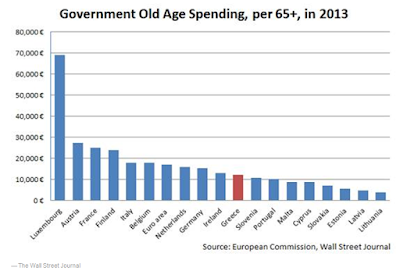There is a claim that many accept and repeat. Greece has generous pensions. This Great Graphic from the Wall Street Journal shows otherwise.Â

Greece’s pension spending was cut by a 13% in the 2012-2013 period as demanded by the IMF, EU and ECB. The fact that Greek pension spending, as a percentage of GDP is the highest in the euro area. This is a distortion of the fact. First, the implosion of the Greek economy (has contracted by more than 25%) exaggerates the measures that use GDP as the denominator, such as pension spending/GDP. A more rational strategy is to increase the denominator rather than cut the numerator.Â
Second, official creditors know well, but have failed to incorporate it into their analysis, that Greece has among the old populations in the euro area. Nearly 20% of the population is 65 or older. This is among the highest in the EU.Â
We have noted previously: The standard retirement age for men has been raised to 67, and since 2010, the public and private sector pensions have been cut from 15% (for the lowest, which is under 500 euros a month) to almost 45% for the highest (3000 euros a month). Now the average pension is 713 euros a month. The typical supplemental pension, generally funded by an industry program, is 169 euros a month. This translates into 60% of pensioners receiving less than 800 euros a month, and leaves 45% living on less than the poverty limit of 665 euros a month.Â

